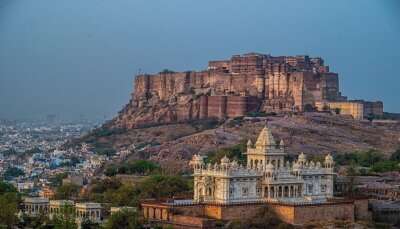Jagdish Temple In Udaipur Is An Exotic Destination For Your Trip To Rajasthan
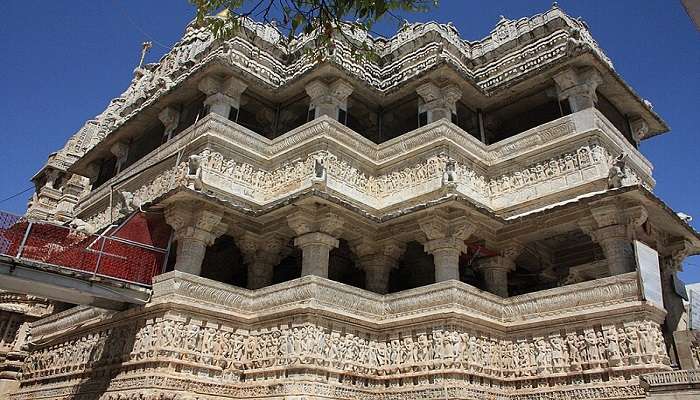
Situated in the heart of Udaipur, Rajasthan, the Jagdish Temple in Udaipur is a majestic testament to the city’s rich heritage and architectural grandeur. Dedicated to Lord Vishnu, this temple is a significant religious site and a cultural landmark that attracts pilgrims, historians, and tourists from around the world. The Jagdish Temple is one of the major shrines in Udaipur in Rajasthan, India. Constructed in 1651 by Maharana Jagat Singh I, it is one of the best specimens of the Indo-Aryan style. The temple is also devoted to Lord Vishnu and is erected to enclose three floors. It is ornate with engravings and premium sculptures. Built within the Udaipur Old City premises, the temple has a pyramid/pavilion-like central spire and measures about 79 ft tall. It has elaborative carvings of elephants, dancers and musicians on the face of the tower. Within, a black stone image of Lord Vishnu as Jagannath, the lord of the universe, is the central deity. Today, the temple is still a functional place where locals come to pray and a primary tourist site that gives a history of Udaipur’s magnificent and historic city.
History Of Jagdish Temple
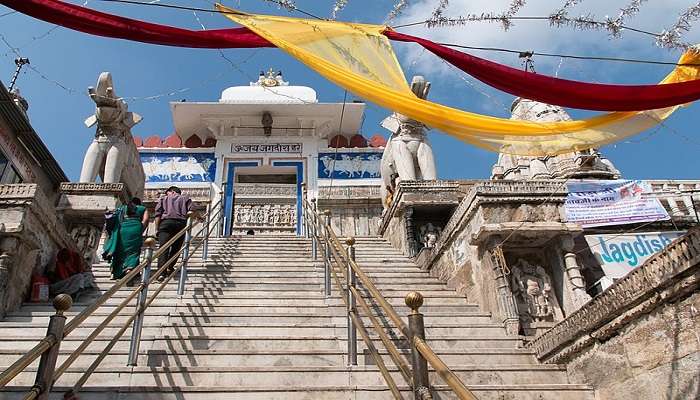
The history of Jagdish Temple dates back to 1651, during the reign of Maharana Jagat Singh I, the ruler of Udaipur. The temple was initially known as Jagannath Rai Temple but later became popularly known as Jagdish Temple. Maharana Jagat Singh, I commissioned the temple to honour Lord Vishnu, one of the principal deities in Hinduism, known as the universe’s preserver. The temple’s construction took around seven years and was built for 1.5 million rupees, a substantial amount at that time.
The temple served as a place of worship and a symbol of the Mewar dynasty’s devotion to and patronage of art and culture. Its strategic location near the City Palace complex further emphasises its importance in the religious and cultural life of Udaipur.
Must Read: Places To Visit In Banswara
Architecture And Art
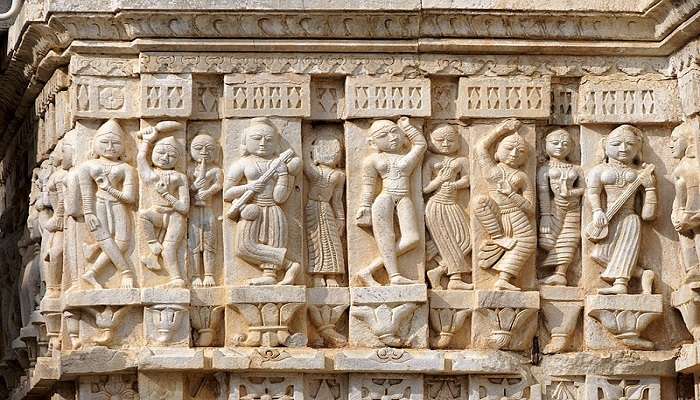
Jagdish Temple is an excellent example of Indo-Aryan architecture. It has a high shikhara, beautifully carved pillars, and sculptures. The temple is symbolized by the raised platform from which it rises and the marvellous forty-two, thirty-two white marble steps leading up to it. The presiding deity is Lord Vishnu, who is known as ‘Jagannath,’ the lord of the universe, made of a single black stone.
- Sanctum Sanctorum (Garbhagriha): The sanctum also has the principal deity of Vishnu, which is beautifully decorated with ornaments and flowers. This image presents the idol of Vishnu, who is four-armed and plays the conch, discus, mace, and lotus.
- Mandapa (Hall): Pillars in the mandapa are designed to accommodate many carving downs with mythological episodes and figures such as apsaras and musicians.
- Shikhara (Spire): One of the tallest mastabas, about 24 meters high, is beautifully decorated with sculptured figures of gods and goddesses, animals, and other celestial bodies. The temple’s spire is highly noticeable in different parts of Udaipur, which shows that it is spiritually vital.
- Entrance Gate (Torana): On the left and right sides of the entrance, there are two big granite elephants that many see as guards or defenders. Floral and geometric designs in the form of carvings are on the walls and roof of the Torana (arched gateway).
This area also contains other Temples of Lord Shiva, Goddess Shakti, and Lord Ganesh, which support Hinduism’s cosmopolitan approach.
Cultural Significance
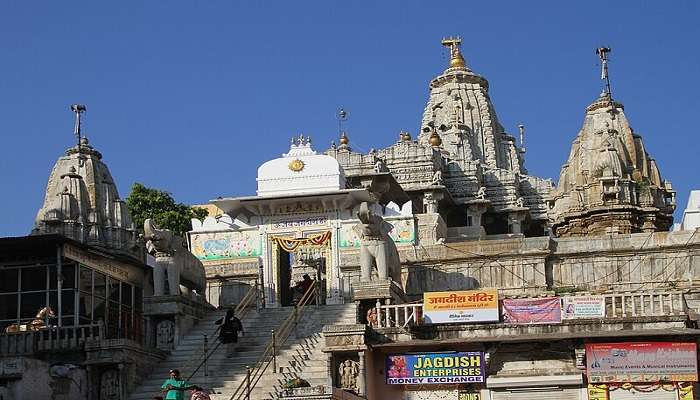
Culture and religion are of exceptional importance to the people of Udaipur. It is also where several religious activities, festivities, and other cultural programmes based on Rajasthan’s colourful history are celebrated. The temple has a schedule of daily rituals that include Mangala Aarti, which is the morning prayer; decoration, commonly referred to as Shringar; offering of food, referred to as Bhoga; and finally, the evening prayers, also known as Sandhya Aarti.
These practices are done with enthusiasm, and these ceremonies attract a large congregation. The temple is much more active, especially during festival times like Janmashtami, Diwali, and Holi. These occasions are characterized by special prayers, music, dance, and cultural programs so that the event can have a joyful outlook. Some typical events to be hosted at the temple complexes include drawings and paintings as well as ballads, with the emphasis on performances from local troupes, especially the traditional Rajasthani troupes.
Suggested Read: Places To Visit In Jodhpur For Couples
How To Get There

- By Air: Another nearby airport is Maharana Pratap Airport, 22 km from Udaipur city. Daily connectivity to and from other major Indian cities such as Delhi, Mumbai, Jaipur, and Bangalore is available. Hired taxis or bus services are available for transportation of the public from the airport to the temple.
- By Train: Udaipur City Railway Station has various rail links to many parts of the country, such as Delhi, Jaipur, Ahmedabad, and Mumbai. After the railway station, local transport facilities include auto-rickshaws, taxis, and buses, which are also available for a temple tour.
- By Road: The National Highways linking Udaipur include NH 76, passing through 260 km to Ahmedabad, 400 km to Jaipur, and 660 km to Delhi. One can easily get state-run buses, private buses, and taxis to commute to Udaipur. When one gets to Udaipur, he or she can be able to get transport to take her or him to the Jagdish Temple.
Further Read: Mumbai to Rajasthan Road Trip
Jagdish Temple is a large Hindu temple in the middle of Udaipur in Rajasthan, just outside the royal palace. It has been in continuous worship since 1651. A big tourist attraction. Now that you have a list of things to remember for your next vacation to see Jagdish Temple in Udaipur, plan your trip to Rajasthan to these fabulous spots for the experience of a lifetime. Don’t miss out on these opportunities, and book your tickets now!
For our editorial codes of conduct and copyright disclaimer, please click here.
Cover Image credit: By Pallav. journo for Wikimedia Commons.
Frequently Asked Questions About Jagdish Temple In Udaipur
When is the best time to visit Jagdish Temple?
The favourable climate for tourism is from October to March; therefore, this is the best time to visit this tourist destination. Rates may vary to accommodate events such as Janmashtami and Diwali and hence it may be advisable to travel there during such festivals.
Is there a restriction fee for accessing the temple?
Jagdish Temple does not charge any entry fee for anyone to pay before visiting it. It is accessible to the public and people are free to observe and even part take in the rituals and other related prayers.
Can I take a picture inside the temple?
Professional photography inside the temple is usually forbidden, however, personal photography is allowed, but it is better to ask the temple officials about any prohibitions during the rituals.
Is there any nearest place to stay a hotel or a motel near the temple?
Touted as the city of lakes, Udaipur has umpteen numbers of accommodation facilities that range from luxury hotels to budget guesthouses. Some of the easy-to-reach places are nearby Lake Pichola and the City Palace is still within walking distance of the temple.
What are the temple timings?
The temple is open from early morning (Daytime refers to the morning prayer which starts at 6:00 AM and is up to midday or noon Then the early morning at around 4:00 AM to the early evening at 6:00 PM while nighttime is from 6:00 PM to 10:00 PM. Still, it is recommended to come and watch the rituals during the specific prayer hours to be more appropriate such as in the morning and in the evening.
People Also Read:
Temples In Bangalore Shri Radhavallabh Lal Ji Temple In Vrindavan Kalachakra Temple In Himachal

Passionate Marketing Student with a flair for storytelling, eagerly embarking on a journey within the vibrant world of travel. Excited to merge analytical acumen with creative skills to elevate the editorial landscape of the travel industry.





